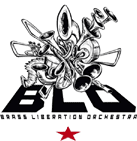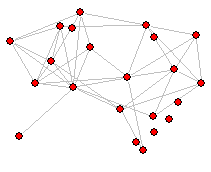 In January 2003, before the start of the current war in Iraq, a group of people in San Francisco began experimenting with ideas of how to respond to the newly increased level of rhetoric and propaganda surrounding issues of US national security. The goal was to sensitize people to the threats to civil liberties implied by the (then) newly proposed government projects such as the renamed, repackaged and re-budgeted “Total Information Awareness” program, while at the same time doing outreach to provide political organizing materials to people on the street in a humorus and provocative way. Continue reading DeptHomelandSecurity.com
In January 2003, before the start of the current war in Iraq, a group of people in San Francisco began experimenting with ideas of how to respond to the newly increased level of rhetoric and propaganda surrounding issues of US national security. The goal was to sensitize people to the threats to civil liberties implied by the (then) newly proposed government projects such as the renamed, repackaged and re-budgeted “Total Information Awareness” program, while at the same time doing outreach to provide political organizing materials to people on the street in a humorus and provocative way. Continue reading DeptHomelandSecurity.com
Direct Action to Stop the War (DASW) Site
 DASW was an SF Bay-area umbrella group for coordinating non-violent direct action against U.S.-lead wars for global domination. Using classic “spokes-council” organizing model, thousands of people were able to coordinate their actions well enough to shut down the SF financial district during the first days of the invasion of Iraq. More than 2000 people were arrested or detained over several days of protest, only a handful were even charged of any crime. The website provided analysis, calls to action, and some information on legal support and non-violent direct action organizing. Although the guts of the website was written by others (DT) I assisted with content management.
DASW was an SF Bay-area umbrella group for coordinating non-violent direct action against U.S.-lead wars for global domination. Using classic “spokes-council” organizing model, thousands of people were able to coordinate their actions well enough to shut down the SF financial district during the first days of the invasion of Iraq. More than 2000 people were arrested or detained over several days of protest, only a handful were even charged of any crime. The website provided analysis, calls to action, and some information on legal support and non-violent direct action organizing. Although the guts of the website was written by others (DT) I assisted with content management.
Brass Liberation Orchestra
 A loose affiliation of radical street musicians. The BLO has helped support a large number of actions and issues in the SF bay area over the last several years. Including helping to shutdown the SF financial district during the protests at the beginning of the Iraq war. Since I don’t actually play a horn, I started out playing snare and now a very large surdo. But I’m kind of a “band member at large” as I’m often not in the bay area.
A loose affiliation of radical street musicians. The BLO has helped support a large number of actions and issues in the SF bay area over the last several years. Including helping to shutdown the SF financial district during the protests at the beginning of the Iraq war. Since I don’t actually play a horn, I started out playing snare and now a very large surdo. But I’m kind of a “band member at large” as I’m often not in the bay area.
The BLO plays a strange mix of music, but lots of influence from various balkan brass bands and creative arrangements of political music from different ages and movements. There is more information, sheet music, etc on the website.
There seems to be increasing numbers of bands like this in the US, which I find very exciting. Were are beginning to join the international sisterhood of radical brass bands. Groups like the now disbanded Infernal Noise Brigade from seattle, the Hungry March Band and Rude Mechanical Orchestra from NYC. There is now a US email list for interested street band folk, and hopefully this fall we will have the first sbandata-style party (sbandapaloza?) in the form of the HONK festival in Boston.
PajekAnimator

PajekAnimator provides a crude way of animating the structural transitions between network layouts at different points in time. The intention is to assist the eye in discovering relationships by providing clear cues about node “movement” using sinusoidal interpolation of the coordinates of nodes at successive points in time. PajekAnimator is a hacked together chunk of Java code meant to be used as a utility /demonstration of concept in conjunction with the network visualization and analysis software, Pajek.
Pajek is Windows-based freeware, written by Vladimir Batagelj and Andrej Mrvar, University of Ljubljana, Slovenia Downloadable from: vlado.fmf.uni-lj.si/pub/networks/pajek/
PajekAnimator was written by skye for John Padgett, University of Chicago.
Bugs and Questions to:
skyebend@santafe.edu
Version 1.0 9/3/01
Download PajekAnimator v1.0 and documentation (ZIP compressed jar)
View documentation (*.txt)
Download Java source code (ZIP file)
Old(er) research interests
This text was written soon after completing my undergrad thesis. Some things have changed, many themes are still the same
Brief Description of Research Interests——
July 2001
I’ve recently started referring to my area of concentration as “Cultural Mechanics†In the broadest sense, I’m interested in the fundamental parameters underlying the phenomena of cultural transmission and real-world socially mediated information exchange. Obviously there are tremendous number of areas which can fit under such a heading. I’m interested in evolutionary theory and questions about gene-culture co-evolution and the impact of the inclusion of cultural parameters into fitness descriptions. I’m intrigued by work being done on mathematical descriptions of cultural transmission processes.
Skye’s Bennington Thesis
Note: This is an HTML adaptation of the version of the thesis from 2001. Some of the ideas are a bit out of date. The original is avalible as a PDF (137 pages, 9.8mb).
Information transmission in social groups:
communication, networks, and interaction
________________________
Skye Bender de-Moll
May 2001
A Thesis submitted to the Faculty of Bennington College, Bennington, Vermont, in partial fulfillment of the requirements for the degree of Bachelor of Arts.
Questions and comments are welcome.
Abstract:
I argue that for information transmission to occur there must be communicative contact between individuals. The patterns of contact then provide a set of outer limits for the extent of information spread. But an examination of a formalized communication process shows that the degree of information or knowledge transmitted may be related to the degree to which the communicants share similar bases of meanings and interpretive schemata. An individual’s cultural properties can be described as a set of schemata, frames, heuristics, historical meanings, and behaviors. Acts of communication among individuals lead to increasing similarity along these cultural dimensions, which may change the likelihood of future interactions, and the effectiveness of existing communicative relations. These longer time scale modifications of social structure often feed back into the process, causing systems to behave in a complex and possibly counter-intuitive manner. Ideally, the analysis of the formal properties and behaviors of such systems might shed some light on some of the observed trends and biases in human communication and the processes involved in the formation of social groups. Analyses of a study of self-report name recognition and communication networks among the incoming class at Bennington College are presented, and some implications discussed.
Introduction to Thesis
On April 16, 2000, a diverse group of activists, anarchists, artists, anti-corporate agitators, union members, and students converged on Washington D.C. Their common purpose, as much as there was one, was to disrupt the meetings of the World Bank and the International Monetary Fund in an attempt to draw attention to their perception of the organizations’ agendas, and to encourage discussion of specific issues which were not being addressed in the political arena. The protesters hoped to build on the success of the Seattle World Trade Organization protest of November 1999, and intended to employ similar tactics . I was among a group of students from Bennington who went down to take part in the rallies. I had some idea of what to expect, but was still blown away by the intensity of the action and the experience. The details of events, political agendas, encounters and their impact upon me are not relevant here. What is important is that, at least in later considerations, the actions and interactions of those three days served to focus my interest on the relationship between communication, the structure of social relations, and human events.
| Fig. 1.a Confrontation between a protester and a man who tried to cross through the line at the IMF/World Bank protest. (Washington D.C. April 16, 2000, photo by author) |
Culture and Social Transmission in Hominids and Non-Humans
“Culture … is that complex whole which includes knowledge, belief, art, morals, law custom, and any other capabilities and habits acquired by man as a member of society.”
-Sir Edward Burnett Tylor (Primitive Culture, 1871)
One of the things which initially prompted me to do research on information transmission and culture was the question of the relationship between genes and culture. I was in an evolution class and doing reading on dynamical systems at the same time. So the question wasn’t so much the near cliché of Nature vs. Nurture, but more how the cultural and genetic influences might play out as a developmental system for generating an individual’s phenotype. There seems to be an odd asymmetry in the evolutionary literature. The mathematical framework for describing the changes in population gene frequencies brought about by differential selection on organisms is very well developed. Many of the implications of the powerful concepts of genetic evolution and fitness lead to explanations of certain social phenomena which are both fascinating and persuasive (kin selection and altruism, for example). But it seems that in many evolutionary models surprisingly little attention is paid to the potential impact of cultural transmission in determining some aspects of the “behavioral phenotype.”
Continue reading Culture and Social Transmission in Hominids and Non-Humans
Adaptation and Models of Cultural Transmission
One of the crucial tools of modern evolutionary thinking is the notion that it is not only necessary to think about how a particular trait or relationship might be beneficial to its holder now, but also what circumstances were required for it to have become an adaptive variation in the first place. It is also essential to consider what structural factors must remain present to keep a trait from being removed from a population – is the behavior an evolutionarily stable strategy, or one which is subject to invasion by more “exploitive” traits? In this context, then, what are the biological-fitness enhancing values of “proto-culture” or communication which might have encouraged its emergence in early humans? Clearly this question is closely related to, and dependent upon, the adaptive value of cognition, consciousness, and communication. Is the continued existence of cultural behaviors which seem biologically maladaptive simply an unavoidable consequence of having big brains and jabbering mouths? Or are there group selection benefits? Are cultural behaviors subject to the same constraints of biological fitness, or do they reside in some other selective regime?
Continue reading Adaptation and Models of Cultural Transmission
Information, Uncertainty, and Meaning
The field of “information theory” or “communications theory” has as its core concept the idea of the transmission of information as the “reduction of uncertainty” about possible states of the source. The definition is very mathematical and involves very specific concepts of “message,” “encoding,” and the characteristics of the channel of transmission. Even though the formalization is in very mechanistic communications theory terms, the idea of reduction of uncertainty is a powerful tool for describing many information and transmission related phenomena. But there are also other common-use conceptions of information which, at least on the surface, appear unrelated to the communications definition. We often speak of objects as “containing information,” as if it were a kind of liquid which could be poured into a book-shaped container by the author and wrung out drop by drop as the reader pages through it. It may be that speaking of information as if it were a substance is simply a convenient short-hand which makes it possible to avoid the headaches and convolutions necessary to describe information as a time-based communicative process. But it is also true that the classic (Shannon, 1948) definition could simply be too rigid to express the complex shifting semantic meaning systems employed by humans in the processes of perception and communication.
